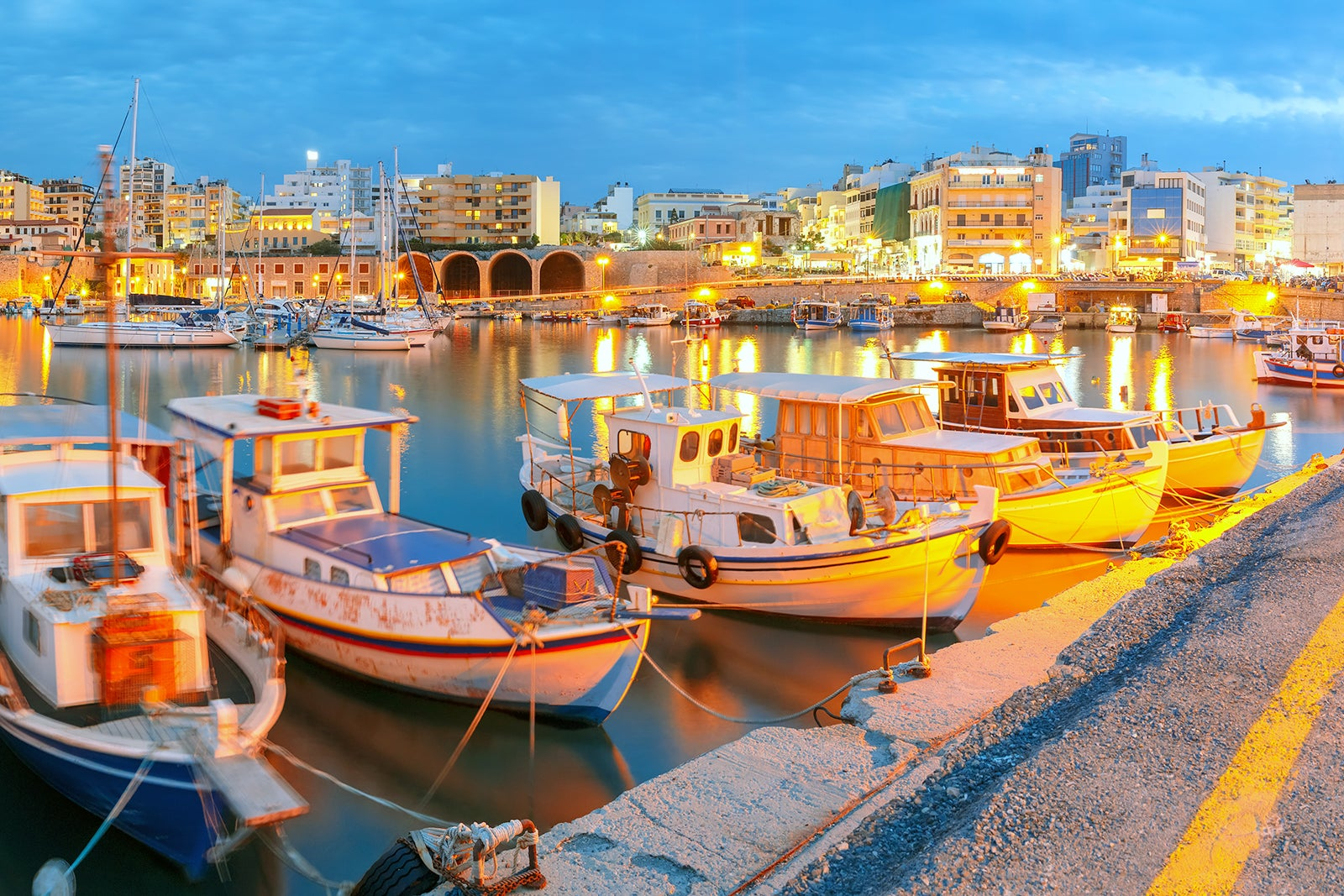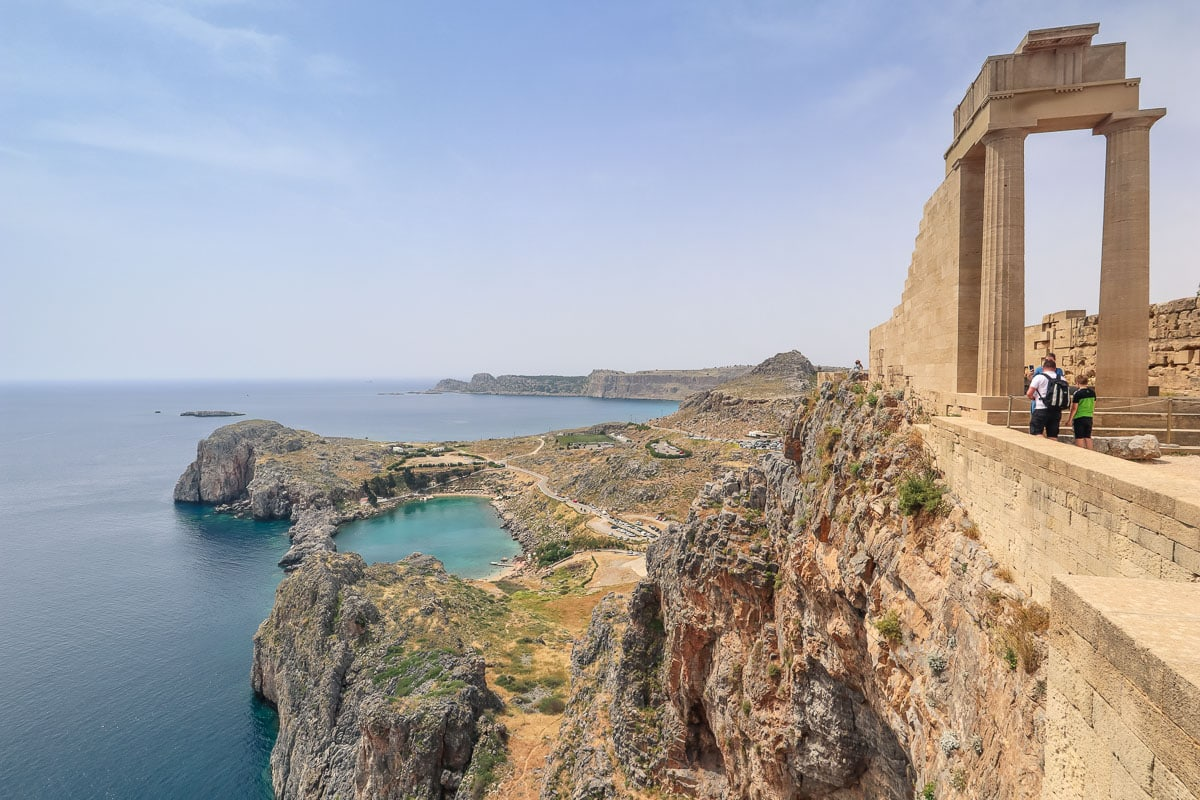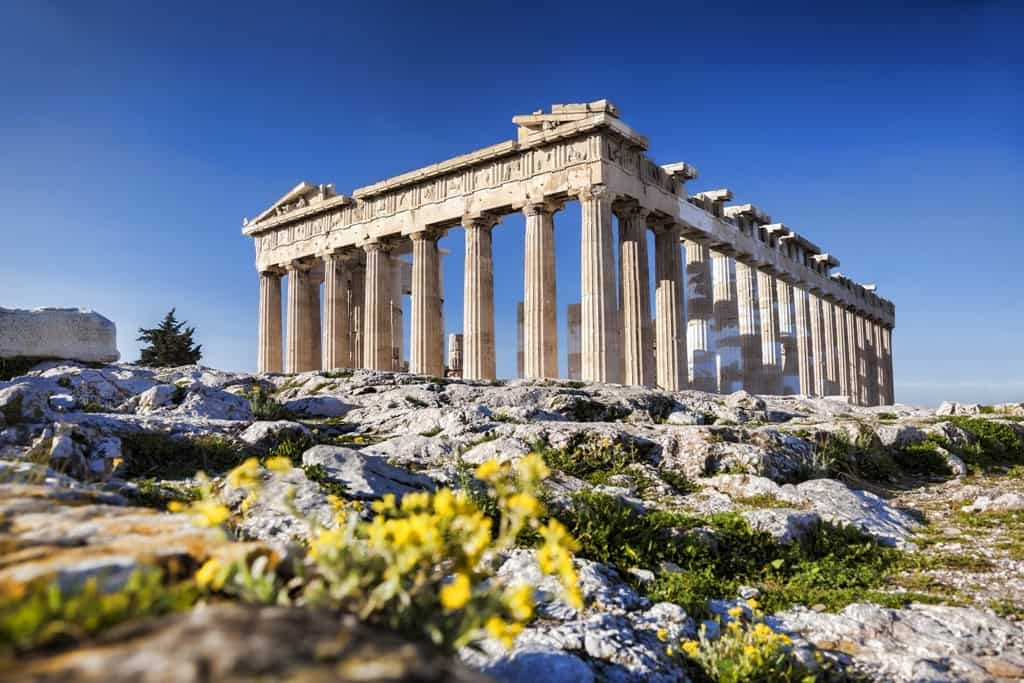The bustling port city of Heraklion is the capital of Crete, Greece’s largest and most southerly island. In 2024, Heraklion offers visitors a heady mix of cultural sights, natural beauty spots, and lively urban energy.
| No. | Activity | Description |
|---|---|---|
| 1 | Marvel at the Palace of Knossos | Explore the Bronze Age Palace of Knossos, a key archaeological site. |
| 2 | Explore Heraklion Archaeological Museum | Visit the museum with a vast collection of Minoan artifacts. |
| 3 | Take a Day Trip to Palace of Phaistos | Discover the ruins of the second-largest Minoan palace. |
| 4 | Wander Around the Venetian Harbor | Enjoy the historic harbor and its medieval buildings. |
| 5 | Relax at Amoudara Beach | Visit Heraklion’s popular sandy beach. |
| 6 | Experience Cretan Culture at the Historical Museum of Crete | Learn about Crete’s history in this museum. |
| 7 | Shop at the Central Market | Browse local produce and delicacies in a bustling market. |
| 8 | Wander the Backstreets of Heraklion | Discover charming lanes and Venetian architecture. |
| 9 | Take a Day Trip to Lake Kournas | Enjoy the scenic lake and its surrounding nature. |
| 10 | Explore Bold New Street Art | View street murals in Heraklion’s vibrant neighborhoods. |
| 11 | See the view from Pontikakos Park | Get panoramic views over Heraklion. |
| 12 | Enjoy Wine Tasting Around Archanes | Sample local wines in the scenic countryside. |
| 13 | Hike the Asterousia Mountains | Explore the rugged mountain range and its trails. |
| 14 | Dance and Dine in the Splantzia Quarter | Experience nightlife in Heraklion’s historic Turkish neighborhood. |
| 15 | Take a Day Trip to Chania | Visit the Venetian quarter and waterfront in Chania. |
From world-famous archaeological sites to relaxing beaches, Heraklion has something for everyone. Here are 15 of the best things to do when visiting this Cretan harbor city in 2024:
Marvel at the Palace of Knossos

Name and Location: The Palace of Knossos is located about 5km southeast of Heraklion city center on Crete. The address is Knossos Iraklio, Crete 71409.
History and Significance: Knossos was the political, religious, and cultural center of the Minoan civilization from 2000-1400 BC. Extensive palace ruins have been excavated and partly reconstructed.
What to Expect: Visitors can explore the sprawling palace complex, seeing ruins of royal apartments, workshops, ceremonial rooms, and frescoes depicting Minoan life.
Visitor Information: Open daily 8am-8pm, April-October until 7:30pm November-March. Admission is €10. Guided tours are worthwhile. Reachable by taxi/bus from Heraklion or tours.
Just 5km outside Heraklion lies the amazing Bronze Age Palace of Knossos, once home to the legendary King Minos and the fearsome mythological Minotaur.
Wander the sprawling ruins and see highlights like vibrant frescoes, grand royal chambers, and the labyrinthine basement. As one of Europe’s most important archaeological sites, Knossos is an essential Heraklion experience.
Explore Heraklion Archaeological Museum

Name and Location: The Heraklion Archaeological Museum is located in Heraklion city center at Xanthoudidou 2.
History and Significance: This museum houses the world’s most significant collection of Minoan artifacts. The exhibits provide insights into Crete’s ancient civilizations.
What to Expect: Visitors can see original frescoes, pottery, jewelry, sculptures and more from royal Minoan sites like Knossos and Phaistos. Top exhibits include the Bull-leaping Fresco and Snake Goddesses.
Visitor Information: Open April-October daily 8am-8pm, November-March daily except Mondays 8:30am-3pm. Admission €10. Audio guides available. Located in city center, walkable or quick taxi ride.
To learn more about Crete’s fascinating ancient Minoan civilization, spend time at the Heraklion Archaeological Museum, one of Greece’s finest.
Here you’ll find the world’s most comprehensive collection of priceless Minoan artifacts, including intricate golden jewelry, frescoes, figurines, and pottery. The museum provides invaluable context for visits to Knossos and Phaistos too.
Take a Day Trip to Palace of Phaistos

Name and Location: The Palace of Phaistos is located near the village of Messara around 40km southwest of Heraklion, Crete.
History and Significance: Phaistos was a major Minoan palace complex dating back to 2000-1400 BC. Impressive ruins include grand staircases, theaters, courts, and frescoes.
What to Expect: Visitors can tour the sprawling hilltop ruins and see highlights like the grand Grand Staircase and Disk of Phaistos artifact. Panoramic views overlook Messara Plain.
Visitor Information: Open daily 8:30am-7:30pm, April–October until 8pm. Admission €8 with discounts available. Organized day tours available from Heraklion. Rental car or taxi also an option.
Venture inland to Phaistos, the second-largest Minoan palace site after Knossos. Dating back to 1900 BC, this sprawling hilltop complex has ancient ruins including imposing grand staircases, storerooms and residences to explore. The scenic drive through olive groves and villages to Phaistos adds to the day’s appeal.
Wander Around the Venetian Harbor

Name and Location: Heraklion’s Venetian Harbor is located right in the city center, surrounded by the historic fortress walls.
History and Significance: The harbor was built in the 13th century by Venetian occupiers. It remains a lively center of dining, shopping, and leisure activities.
What to Expect: Visitors can stroll along the waterfront promenade lined with restaurants, cafes, and boats. The Harbor-side attractions include the Koules Fortress, Historical Museum, and frescoed Church of Agios Titos.
Visitor Information: The harbor is open 24/7 and can be reached on foot from anywhere in central Heraklion. Boat tours of the harbor are available during the day.
Soak up Heraklion’s maritime atmosphere with a stroll around the historic Venetian harbor, lined with pastel-hued medieval buildings. Look for the imposing Koules Fortress, the arched Arsenali shipyards, and the grand Venetian Loggia. Enjoy fresh seafood with harbor views at one of the many waterside restaurants.
Relax at Amoudara Beach

Name and Location: Amoudara Beach is located along the northern coast of Crete, about 6km west of downtown Heraklion.
History and Significance: Amoudara has been a popular seaside resort area since the 1970s. Its sandy beach stretches over 6km on the Aegean Sea.
What to Expect: Visitors come to swim, sunbathe, and enjoy the full range of amenities including beach chairs & umbrellas, showers, water sports, cafes, and lodging.
Visitor Information: Beach access is free and open daily sunrise to sunset. Public bus #15 runs regularly from Heraklion. Parking available along the seaside road. Beach is generally uncrowded outside peak summer months.
Just a 10-minute drive east of Heraklion, Amoudara Beach is the city’s most popular seaside spot. Its long sandy beach features resorts and tavernas, while the azure waters are ideal for swimming and watersports. Spend a day sunbathing on the sand before enjoying a sunset promenade along the palm-fringed seafront.
Experience Cretan Culture at the Historical Museum of Crete

Name and Location: The Historical Museum of Crete is located in Heraklion at Sofokli Venizelou Avenue. It is housed in a 1903 mansion.
History and Significance: This museum depicts Cretan history and culture from early Byzantine times to the 20th century. It is one of the most important museums in Greece.
What to Expect: Visitors can see Cretan artwork, costumes, tools, weapons, and other artifacts. Highlights include frescoes, carved doors, and silverwork. The museum offers insights into local culture.
Visitor Information: Open April-October daily 9am-5pm. November-March daily except Mondays 10am-5pm. Admission €5 with discounts available. Located steps from the city center.
Gain insight into Crete’s colorful past at the excellent Historical Museum of Crete in downtown Heraklion. Located in a former Venetian monastery, its exhibits profile the island’s history and culture from early Christian times through Venetian, Ottoman and modern eras via artifacts, artwork, clothing and recreations.
Shop at the Central Market

Name and Location: Heraklion Central Market is located in Heraklion city center between 1866 Street and Daidalou Street near the Morosini Fountain.
History and Significance: Heraklion’s covered food market has operated since 1913. It offers fresh, local produce and food staples that reflect Cretan cuisine and culture.
What to Expect: Visitors will find stalls selling Cretan olive oils, cheeses, honey, herbs, baked goods, meats, and more. The market offers foodie souvenirs and an authentic local shopping experience.
Visitor Information: Open Monday-Saturday 6am-9pm. Best to go early morning when sellers are most active. Cash only at most stalls. Located steps from Lion Square in the heart of Heraklion.
For a taste of local life, browse Heraklion’s Central Market just south of Lions Square. This large covered hall is crammed with fresh produce from across Crete. Sample cheeses, olive oils, mountain herbs and Cretan wines. Don’t miss the fish, meat and deli stalls too. The surrounding streets are filled with cafes perfect for people-watching.
Wander the Backstreets of Heraklion

Name and Location: Heraklion’s backstreets lie in the residential neighborhoods west and south of the harbor in the city center. The Daidalou Pedestrian Zone is a prime starting point.
History and Significance: These charming, narrow lanes provide insights into daily life in Heraklion away from the main tourist zones. Wandering here offers a more authentic experience.
What to Expect: Visitors can explore sleepy backstreets lined with pastel-colored houses, hidden churches, corner tavernas, and local shops. Glimpses of everyday life abound.
Visitor Information: Streets are open 24/7. Morning or evening walks are most atmospheric and provide escape from daytime heat. Travel with a map as lanes can be winding.
Venture into Heraklion’s backstreets to uncover charm beneath the hustle and bustle. Weaving pedestrianized lanes are lined with traditional Cretan tavernas, cozy cafes, hole-in-the-wall shops and remnants of Venetian architecture like the Saint Mark’s Basilica. The area around Korai and Daidalou Streets is great for wandering.
Take a Day Trip to Lake Kournas

Name and Location: Lake Kournas is located inland in the mountains about 25 km southeast of Heraklion, Crete. The lake sits in a beautiful natural setting surrounded by hills dotted with whitewashed churches.
History and Significance: Lake Kournas is Crete’s only freshwater lake. It covers an area of about 579,000 square meters and reaches a depth of 22.5 meters. The area is rich in biodiversity.
What to Expect: Activities include boat tours of the lake, swimming, horseback riding, taverna dining along the shore, and walking in the surrounding hills. The scenery is idyllic.
Visitor Information: The area is accessible year-round. Tour buses make day trips from Heraklion. Renting a car provides more flexibility. Boats operate April to October usually.
Hire a car and drive through the lush Crete countryside to beautiful Lake Kournas, nestled at the foot of the White Mountains.
Enjoy the magnificent scenery and wildlife, relax on the small beach, or pedal a swan-shaped pedalo onto the serene turquoise waters. The nearby hillside village of Argyroupoli is also worth a stop.
Explore Bold New Street Art

Name and Location: Vibrant street art murals can be found across neighborhoods in Heraklion, especially the University district around Korai Square.
History and Significance: Heraklion’s street art scene has boomed since the 2010s. The artworks reflect both local culture and global messages.
What to Expect: Visitors can discover large colorful murals depicting Cretan life and mythology. More political, avant-garde works are also prominent. Top artists include Insane51.
Visitor Information: Many works are visible simply walking around the city center and University neighborhood. Joining a guided street art tour provides deeper insights.
Street art flourishes in Heraklion, transforming facades into striking outdoor art galleries. Seek out large colorful murals by Greek and foreign artists that tackle themes like Greek mythology, nature, and modern life. The student neighborhoods around the University campus feature impressive examples.
See the view from Pontikakos Park

Name and Location: Pontikakos Park is located on Martinengo Bastion at the highest point within the walls of Heraklion, Crete overlooking the harbor.
History and Significance: These gardens occupy a 16th century bastion with panoramic views of Heraklion. The Bastion takes its name from the Martinengo family, who governed Heraklion 1463-1669.
What to Expect: Visitors can enjoy walking paths, scenic overlooks, a small fountain, and aromatic plants. Photographers flock here to capture iconic harbor views.
Visitor Information: The park is open daily year-round from 8am to 9pm. Entry is free. It can be accessed on foot easily from downtown Heraklion a short uphill walk from the harbor.
For incredible panoramic views over Heraklion, head up to Pontikakos Park located on the city’s western hillside. Gaze across the red tile rooftops to the harbor, catch sunset silhouetting the mountains, and see all the way to the peaks of Psiloritis and Dikti. Have a drink at the open-air cafe while soaking up the vistas.
Enjoy Wine Tasting Around Archanes

Name and Location: Archanes is a town about 15km south of Heraklion, renowned for its winemaking and traditional villages.
History and Significance: Archanes has produced wine since the Minoan era. Local grapes include Kotsifali, Mandilari, Malvasia, and Vidiano. Many boutique wineries offer tours and tastings.
What to Expect: Tours visit picturesque wine estates to sample wines paired with local olive oils, cheeses, and snacks while learning about Cretan varietals and winemaking.
Visitor Information: Tours are typically 2-4 hours and cost around €25-50. Transportation options include rental car, private tour, or public bus from Heraklion. Make reservations in advance.
The scenic wine country around Archanes, just 15km south of Heraklion, is perfect for indulging in some Cretan wine tasting. Sip your way through local grape varieties like kotsifali, vilana, and mandilari at charming wineries set amidst rolling vineyards. Many offer delicious platters of cheeses, charcuterie, and olive oil too.
Hike the Asterousia Mountains

Name and Location: The Asterousia Mountains are located in south central Crete, south of Heraklion. The main village base is Kastamonitsa.
History and Significance: These rugged limestone mountains contain over 100 peaks above 2000 feet, cradling quaint villages and the Katagyri cave system. The area offers superb hiking.
What to Expect: Trails range from easy village walks to steep climbs over 6,000 feet. Highlights include Cave of Zeus, ancient paths, birdlife, wildflowers, and mountain scenery.
Visitor Information: Reach the mountains around Heraklion via rental car/tours. Hiking maps available locally. Experience is recommended for advanced hikes. Avoid peak summer heat.
Get a dose of Cretan natural beauty with a hike in the rugged Asterousia mountain range, under an hour’s drive south of Heraklion. Trails lead past sheer cliffs, deep gorges, and fascinating cave churches. After working up an appetite, tuck into fresh mountain fare at a tiny off-the-beaten-path taverna.
Dance and Dine in the Splantzia Quarter

Name and Location: The Splantzia Quarter surrounds the old Turkish borough around the church of Agios Minas in central Heraklion, Crete.
History and Significance: Splantzia dates to the Byzantine and Turkish periods, with many structures from the 13th-19th centuries. The area offers charming backstreets, tavernas, and nightlife.
What to Expect: By evening, visitors fill lively tavernas to dine on classic Cretan cuisine while listening to traditional Mantinades music and watching Greek dancing.
Visitor Information: Splantzia is very walkable from the harbor. Follow Choudetsi or Halidon Streets. Tavernas are typically open 6pm-midnight or later.
By night, find lively bars, ouzeris and music in the atmospheric Splantzia Quarter, Heraklion’s historic Turkish neighborhood.
Meander narrow alleys before settling in for dinner at one of the excellent family-run tavernas. Then check out the bustling bars where locals and visitors mingle over raki cocktails until the wee hours.
Take a Day Trip to Chania

Name and Location: Chania is a historic port city located about 70 miles west of Heraklion on the northwest coast of Crete.
History and Significance: Chania was founded by the Minoans over 4000 years ago. The city features both Venetian and Ottoman influences, along with pretty waterfront scenery.
What to Expect: Popular activities include strolling the pretty Venetian Harbor, visiting the iconic lighthouse, shopping at the Public Market, and enjoying fresh seafood cuisine.
Visitor Information: Day tours operate from Heraklion for around 70-80 euros. Renting a car or public bus are more budget-friendly options for reaching Chania. At least 1 night is ideal to fully experience the city.
Explore more of Crete with a day trip west along the coast to Chania, the island’s second city famed for its pretty Venetian quarter, Turkish minarets and waterfront dining scene.
Wander the 16th century harbour, try glass-bottomed boat tours and visit top museums. The scenic drive there crosses olive groves and follows the sea.
Visit the Palace of Malia

Name and Location: The Palace of Malia is located 3km east of the coastal town of Malia in northeast Crete, about 35km from Heraklion.
History and Significance: This key Minoan palace complex dates to 1900-1600 BC. It is the third largest Minoan palace discovered on Crete after Knossos and Phaistos.
What to Expect: Visitors can tour the sprawling ruins, which include ceremonial rooms, workshops, storage areas, and ruins of over 1,000 cylindrical storage jars. A small museum displays artifacts.
Visitor Information: Open summer daily 8am-7:40pm, winter to 3:40pm. Admission €6. Reachable via rental car or tour bus from Heraklion. The trip takes around 1 hour by car.
For ancient history, take a day trip east of Heraklion to explore the sprawling Minoan Palace of Malia. Dating to 1900 BC, highlights here include the royal residences, shrines, workshops and even an ancient theater. The pottery exhibits in the onsite museum help bring the ruins to life. Combine with wine tasting in Malia village.
Conclusion
With its blend of fascinating archaeological treasures, vibrant urban energy and relaxed Mediterranean lifestyle, Heraklion is an enthralling destination in 2024.
From majestic palace ruins to cutting-edge museums, gourmet cuisine to non-stop nightlife, visitors can immerse themselves in Cretan history and culture. Whether you seek ancient sites or sunny beaches, Heraklion delivers an unforgettable Greek experience.





Join the Conversation